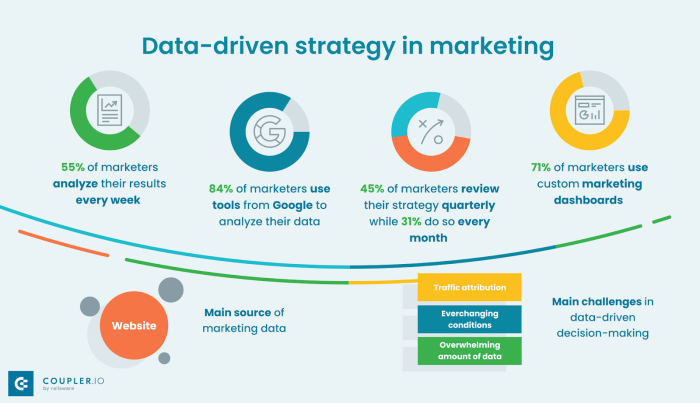Developing Data-Driven Marketing Content dives into the realm of utilizing data to revolutionize marketing strategies, creating a dynamic and impactful narrative right from the start.
Exploring the significance of data-driven content and how it can elevate marketing efforts to new heights will be the focus of this discussion.
Understanding Data-Driven Marketing Content

Data-driven marketing content refers to the creation and implementation of marketing strategies based on insights and analysis of data collected from various sources. This approach involves using customer data, trends, and patterns to tailor marketing campaigns to specific audiences, resulting in more personalized and effective communication with potential customers.Utilizing data in marketing strategies is crucial for businesses to stay competitive in today’s digital landscape.
By leveraging data analytics tools, companies can gain a deeper understanding of their target audience, identify market trends, and measure the success of their marketing efforts. This allows businesses to make informed decisions, optimize their campaigns, and ultimately drive better results.
Examples of Successful Data-Driven Marketing Campaigns
- Netflix: Utilizes user data to recommend personalized content based on viewing history, preferences, and behavior. This data-driven approach has significantly contributed to customer retention and engagement.
- Amazon: Customizes product recommendations and email marketing campaigns based on customer browsing history and purchase behavior. This personalized marketing strategy has led to increased sales and customer loyalty.
- Sephora: Uses customer data to provide personalized product recommendations, beauty tips, and exclusive offers through their mobile app. This data-driven marketing approach has enhanced the overall customer experience and increased brand loyalty.
Collecting Data for Marketing Content
When it comes to creating data-driven marketing content, collecting relevant data is key to understanding your target audience and delivering personalized messages. By leveraging various sources and methods, businesses can gather valuable customer insights to inform their marketing strategies.
Identifying Sources for Data Collection
- Social media platforms: Monitor engagement metrics, comments, and direct messages to understand customer preferences and behaviors.
- Website analytics: Track website traffic, bounce rates, and conversion rates to analyze user interactions and optimize content.
- Email marketing: Utilize email open rates, click-through rates, and subscriber demographics to tailor content based on audience interests.
- Customer surveys: Conduct surveys to gather feedback, preferences, and opinions directly from your target audience.
Methods for Gathering Customer Data
- Data mining: Extract valuable insights from large datasets to identify patterns, trends, and correlations.
- Customer relationship management (CRM) systems: Centralize customer data to track interactions, transactions, and preferences for personalized marketing.
- Online tracking tools: Use cookies and tracking pixels to collect user behavior data for targeted advertising and content personalization.
Role of Analytics in Data Collection
Analytics play a crucial role in data collection by providing businesses with the tools to analyze and interpret data effectively. By using analytics tools, businesses can measure the performance of marketing campaigns, identify areas for improvement, and make data-driven decisions to optimize their content strategies.
Analyzing Data for Effective Content
In the world of marketing, analyzing data is crucial for creating effective content that resonates with the target audience. By examining data insights, marketers can better understand consumer behavior, preferences, and trends to tailor their content strategy accordingly.
Different Data Analysis Tools
- Google Analytics: A popular tool for tracking website traffic, user behavior, and conversions.
- SEMrush: Helps analyze competitor strategies, performance, and opportunities.
- HubSpot: Provides insights on lead generation, customer interactions, and campaign performance.
Enhancing Content Creation with Data Analysis
By leveraging data analysis, marketers can optimize their content creation process in various ways:
- Personalization: Data analysis allows for personalized content recommendations based on user preferences and behavior.
- Optimization: By analyzing performance metrics, marketers can identify high-performing content and optimize future campaigns.
- Trend Identification: Data analysis helps in spotting emerging trends and adjusting content strategies to stay relevant.
Creating Engaging Data-Driven Content: Developing Data-Driven Marketing Content
In today’s digital age, creating engaging content is crucial for capturing the attention of your target audience. By incorporating data insights into your content creation process, you can tailor your messaging to resonate with your audience on a deeper level.Personalizing content based on data analysis allows you to deliver relevant and timely information to your audience. By understanding their preferences, behaviors, and demographics, you can create content that speaks directly to their needs and interests.
This personalized approach not only increases engagement but also builds a stronger connection with your audience.
Strategies for Incorporating Data Insights
- Utilize customer segmentation to create targeted content for different audience groups.
- Use A/B testing to understand which types of content resonate best with your audience.
- Monitor data analytics regularly to identify trends and patterns that can inform your content strategy.
Personalizing Content for Maximum Impact
- Address your audience by their name or location to create a sense of personalization.
- Recommend products or services based on their previous interactions with your brand.
- Create dynamic content that adapts based on user behavior or preferences.
Tips for Making Data-Driven Content Engaging
- Use storytelling to make data more relatable and engaging for your audience.
- Incorporate interactive elements such as quizzes or polls to encourage audience participation.
- Create visually appealing content with infographics, videos, or animations to grab attention.
Implementing Data-Driven Content in Marketing Campaigns

Implementing data-driven content in marketing campaigns involves several key steps to ensure success. By leveraging data insights, marketers can create personalized and targeted content that resonates with their audience, ultimately driving engagement and conversions.
Utilizing Customer Data, Developing Data-Driven Marketing Content
- Collecting and analyzing customer data to understand preferences and behavior patterns.
- Segmenting audiences based on demographics, interests, and previous interactions with the brand.
- Personalizing content to deliver tailored messaging that speaks to the individual needs of each segment.
Optimizing Content Performance
- Testing different variations of content to identify what resonates best with each audience segment.
- Utilizing A/B testing to compare the performance of different content elements and optimize for conversion.
- Iterating on content based on data insights to continuously improve performance over time.
Measuring and Analyzing Results
- Tracking key performance indicators (KPIs) to measure the impact of data-driven content on marketing campaigns.
- Analyzing data to identify trends, patterns, and opportunities for further optimization.
- Using data insights to make informed decisions and adjustments to future content strategies.
